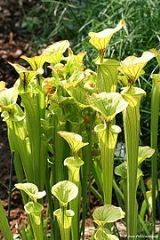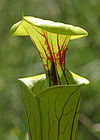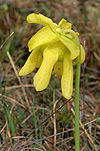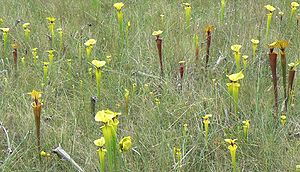
Sarracenia flava
Encyclopedia
Sarracenia flava, the Yellow pitcher plant, is a carnivorous plant
in the family Sarraceniaceae
. Like all the Sarraceniaceae, it is native to the New World
. Its range extends from southern Alabama
, through Florida
and Georgia
, to the coastal plains of southern Virginia
, North Carolina
and South Carolina
. Populations also exist in the Piedmont
and mountains of North Carolina
.

 Like other members of the genus
Like other members of the genus
Sarracenia
, the yellow pitcher plant traps insects using a rolled leaf, which in this species is a vibrant yellow in color, and up to over a meter in height (although 50 cm is more typical). The uppermost part of the leaf is flared into a lid (the operculum
), which prevents excess rain from entering the pitcher and diluting the digestive secretions
within. The upper regions of the pitcher are covered in short, stiff, downwards-pointing hairs, which serve to guide insect
s alighting on the upper portions of the leaf towards the opening of the pitcher tube. The upper regions are also brightly patterned with flower-like anthocyanin
markings, particularly in the varieties S. flava var. rugelii and S. flava var. ornata: these markings also serve to attract insect prey. The opening of the pitcher tube is retroflexed into a 'nectar roll' or peristome
, whose surface is studded with nectar-secreting glands. The nectar contains not only sugar
s, but also the alkaloid
coniine
(a toxin
also found in hemlock
), which probably intoxicates the prey. Prey entering the tube find that their footing is made extremely uncertain by the smooth, wax
y secretions found on the surfaces of the upper portion of the tube. Insects losing their footing on this surface plummet to the bottom of the tube, where a combination of digestive fluid, wetting agents and inward-pointing hairs prevent their escape. Some large insects (such as wasp
s) have been reported to escape from the pitchers on occasion, by chewing their way out through the wall of the tube.
In spring
, the plant produces large flower
s with 5-fold symmetry
. The yellow petal
s are long and strap-like, and dangle over the umbrella
-like style of the flower, which is held upside down at the end of a 50 cm long scape
. The stigma of the flower are found at the tips of the 'spokes' of this umbrella. Pollinating insects generally enter the flower from above, forcing their way into the cavity between the petals and umbrella, and depositing any pollen they are carrying on the stigmata as they enter. The pollinators generally exit the flower, having been dusted with the plant's own pollen, by lifting a petal. This one-way system helps to ensure cross pollination.
 In late summer and autumn, the plant stops producing carnivorous leaves, and instead produces flat, non-carnivorous phyllodia. This is probably an adaptation to low light levels and insect scarcity during the winter months, and shows clearly the cost of carnivory.
In late summer and autumn, the plant stops producing carnivorous leaves, and instead produces flat, non-carnivorous phyllodia. This is probably an adaptation to low light levels and insect scarcity during the winter months, and shows clearly the cost of carnivory.
The yellow pitcher plant is easy to cultivate, and is one of the most popular carnivorous plants in horticulture
. The yellow pitcher plant readily hybridises with other members of the genus Sarracenia: the hybrids S. x catesbaei (S. flava × S. purpurea) and S. moorei (S. flava × S. leucophylla) are found in the wild, and are also popular amongst collectors.
Carnivorous plant
Carnivorous plants are plants that derive some or most of their nutrients from trapping and consuming animals or protozoans, typically insects and other arthropods. Carnivorous plants appear adapted to grow in places where the soil is thin or poor in nutrients, especially nitrogen, such as acidic...
in the family Sarraceniaceae
Sarraceniaceae
Sarraceniaceae is a family of pitcher plants , belonging to order Ericales .The family comprises three extant genera: Sarracenia , Darlingtonia , and Heliamphora . The extinct Archaeamphora longicervia may also belong to this family...
. Like all the Sarraceniaceae, it is native to the New World
New World
The New World is one of the names used for the Western Hemisphere, specifically America and sometimes Oceania . The term originated in the late 15th century, when America had been recently discovered by European explorers, expanding the geographical horizon of the people of the European middle...
. Its range extends from southern Alabama
Alabama
Alabama is a state located in the southeastern region of the United States. It is bordered by Tennessee to the north, Georgia to the east, Florida and the Gulf of Mexico to the south, and Mississippi to the west. Alabama ranks 30th in total land area and ranks second in the size of its inland...
, through Florida
Florida
Florida is a state in the southeastern United States, located on the nation's Atlantic and Gulf coasts. It is bordered to the west by the Gulf of Mexico, to the north by Alabama and Georgia and to the east by the Atlantic Ocean. With a population of 18,801,310 as measured by the 2010 census, it...
and Georgia
Georgia (U.S. state)
Georgia is a state located in the southeastern United States. It was established in 1732, the last of the original Thirteen Colonies. The state is named after King George II of Great Britain. Georgia was the fourth state to ratify the United States Constitution, on January 2, 1788...
, to the coastal plains of southern Virginia
Virginia
The Commonwealth of Virginia , is a U.S. state on the Atlantic Coast of the Southern United States. Virginia is nicknamed the "Old Dominion" and sometimes the "Mother of Presidents" after the eight U.S. presidents born there...
, North Carolina
North Carolina
North Carolina is a state located in the southeastern United States. The state borders South Carolina and Georgia to the south, Tennessee to the west and Virginia to the north. North Carolina contains 100 counties. Its capital is Raleigh, and its largest city is Charlotte...
and South Carolina
South Carolina
South Carolina is a state in the Deep South of the United States that borders Georgia to the south, North Carolina to the north, and the Atlantic Ocean to the east. Originally part of the Province of Carolina, the Province of South Carolina was one of the 13 colonies that declared independence...
. Populations also exist in the Piedmont
Piedmont (United States)
The Piedmont is a plateau region located in the eastern United States between the Atlantic Coastal Plain and the main Appalachian Mountains, stretching from New Jersey in the north to central Alabama in the south. The Piedmont province is a physiographic province of the larger Appalachian division...
and mountains of North Carolina
North Carolina
North Carolina is a state located in the southeastern United States. The state borders South Carolina and Georgia to the south, Tennessee to the west and Virginia to the north. North Carolina contains 100 counties. Its capital is Raleigh, and its largest city is Charlotte...
.


Genus
In biology, a genus is a low-level taxonomic rank used in the biological classification of living and fossil organisms, which is an example of definition by genus and differentia...
Sarracenia
Sarracenia
Sarracenia is a genus comprising 8 to 11 species of North American pitcher plants. The genus belongs to the family Sarraceniaceae, which also contain the closely allied genera Darlingtonia and Heliamphora....
, the yellow pitcher plant traps insects using a rolled leaf, which in this species is a vibrant yellow in color, and up to over a meter in height (although 50 cm is more typical). The uppermost part of the leaf is flared into a lid (the operculum
Operculum (botany)
An operculum, in botany, is a term generally used to describe a structure within a plant, moss, or fungus acting as a cap, flap, or lid. In plants, it may also be called a bud cap.Examples of structures identified as opercula include:...
), which prevents excess rain from entering the pitcher and diluting the digestive secretions
Digestion
Digestion is the mechanical and chemical breakdown of food into smaller components that are more easily absorbed into a blood stream, for instance. Digestion is a form of catabolism: a breakdown of large food molecules to smaller ones....
within. The upper regions of the pitcher are covered in short, stiff, downwards-pointing hairs, which serve to guide insect
Insect
Insects are a class of living creatures within the arthropods that have a chitinous exoskeleton, a three-part body , three pairs of jointed legs, compound eyes, and two antennae...
s alighting on the upper portions of the leaf towards the opening of the pitcher tube. The upper regions are also brightly patterned with flower-like anthocyanin
Anthocyanin
Anthocyanins are water-soluble vacuolar pigments that may appear red, purple, or blue according to pH...
markings, particularly in the varieties S. flava var. rugelii and S. flava var. ornata: these markings also serve to attract insect prey. The opening of the pitcher tube is retroflexed into a 'nectar roll' or peristome
Peristome
The word peristome is derived from the Greek peri, meaning 'around' or 'about', and stoma, 'mouth'. It is a term used to describe various anatomical features that surround an opening to an organ or structure. The term is used in plants and invertebrate animals, such as in describing the shells of...
, whose surface is studded with nectar-secreting glands. The nectar contains not only sugar
Sugar
Sugar is a class of edible crystalline carbohydrates, mainly sucrose, lactose, and fructose, characterized by a sweet flavor.Sucrose in its refined form primarily comes from sugar cane and sugar beet...
s, but also the alkaloid
Alkaloid
Alkaloids are a group of naturally occurring chemical compounds that contain mostly basic nitrogen atoms. This group also includes some related compounds with neutral and even weakly acidic properties. Also some synthetic compounds of similar structure are attributed to alkaloids...
coniine
Coniine
Coniine is a poisonous alkaloid found in poison hemlock and the yellow pitcher plant, and contributes to hemlock's fetid smell. It is a neurotoxin which disrupts the peripheral nervous system. It is toxic to humans and all classes of livestock; less than 0.2g is fatal to humans, with death caused...
(a toxin
Toxin
A toxin is a poisonous substance produced within living cells or organisms; man-made substances created by artificial processes are thus excluded...
also found in hemlock
Conium
Conium is a genus of two species of highly poisonous perennial herbaceous flowering plants in the family Apiaceae, native to Europe and the Mediterranean region as Conium maculatum, and to southern Africa as Conium chaerophylloides....
), which probably intoxicates the prey. Prey entering the tube find that their footing is made extremely uncertain by the smooth, wax
Wax
thumb|right|[[Cetyl palmitate]], a typical wax ester.Wax refers to a class of chemical compounds that are plastic near ambient temperatures. Characteristically, they melt above 45 °C to give a low viscosity liquid. Waxes are insoluble in water but soluble in organic, nonpolar solvents...
y secretions found on the surfaces of the upper portion of the tube. Insects losing their footing on this surface plummet to the bottom of the tube, where a combination of digestive fluid, wetting agents and inward-pointing hairs prevent their escape. Some large insects (such as wasp
Wasp
The term wasp is typically defined as any insect of the order Hymenoptera and suborder Apocrita that is neither a bee nor an ant. Almost every pest insect species has at least one wasp species that preys upon it or parasitizes it, making wasps critically important in natural control of their...
s) have been reported to escape from the pitchers on occasion, by chewing their way out through the wall of the tube.
In spring
Spring (season)
Spring is one of the four temperate seasons, the transition period between winter and summer. Spring and "springtime" refer to the season, and broadly to ideas of rebirth, renewal and regrowth. The specific definition of the exact timing of "spring" varies according to local climate, cultures and...
, the plant produces large flower
Flower
A flower, sometimes known as a bloom or blossom, is the reproductive structure found in flowering plants . The biological function of a flower is to effect reproduction, usually by providing a mechanism for the union of sperm with eggs...
s with 5-fold symmetry
Symmetry
Symmetry generally conveys two primary meanings. The first is an imprecise sense of harmonious or aesthetically pleasing proportionality and balance; such that it reflects beauty or perfection...
. The yellow petal
Petal
Petals are modified leaves that surround the reproductive parts of flowers. They often are brightly colored or unusually shaped to attract pollinators. Together, all of the petals of a flower are called a corolla. Petals are usually accompanied by another set of special leaves called sepals lying...
s are long and strap-like, and dangle over the umbrella
Umbrella
An umbrella or parasol is a canopy designed to protect against rain or sunlight. The term parasol usually refers to an item designed to protect from the sun; umbrella refers to a device more suited to protect from rain...
-like style of the flower, which is held upside down at the end of a 50 cm long scape
Scape
In biology, the term scape may refer to:* The first segment of an insect antenna* A finger-like appendage of the epigyne of a female spider* Scape , a flowering stemScape may also refer to:...
. The stigma of the flower are found at the tips of the 'spokes' of this umbrella. Pollinating insects generally enter the flower from above, forcing their way into the cavity between the petals and umbrella, and depositing any pollen they are carrying on the stigmata as they enter. The pollinators generally exit the flower, having been dusted with the plant's own pollen, by lifting a petal. This one-way system helps to ensure cross pollination.

The yellow pitcher plant is easy to cultivate, and is one of the most popular carnivorous plants in horticulture
Horticulture
Horticulture is the industry and science of plant cultivation including the process of preparing soil for the planting of seeds, tubers, or cuttings. Horticulturists work and conduct research in the disciplines of plant propagation and cultivation, crop production, plant breeding and genetic...
. The yellow pitcher plant readily hybridises with other members of the genus Sarracenia: the hybrids S. x catesbaei (S. flava × S. purpurea) and S. moorei (S. flava × S. leucophylla) are found in the wild, and are also popular amongst collectors.

